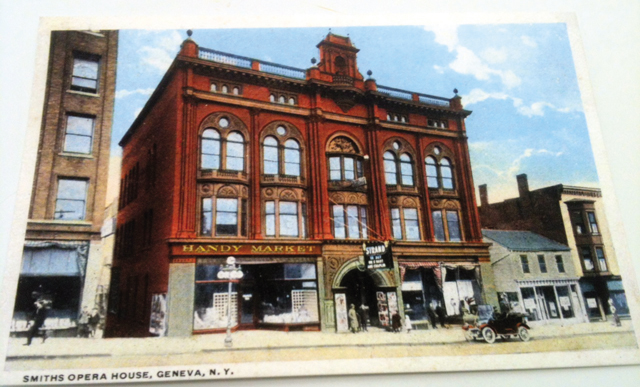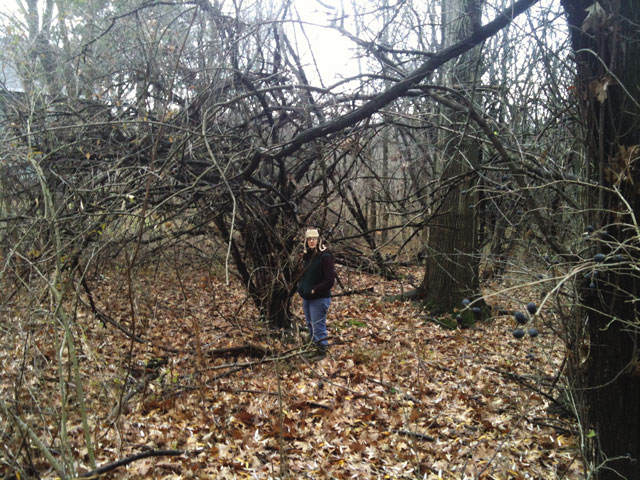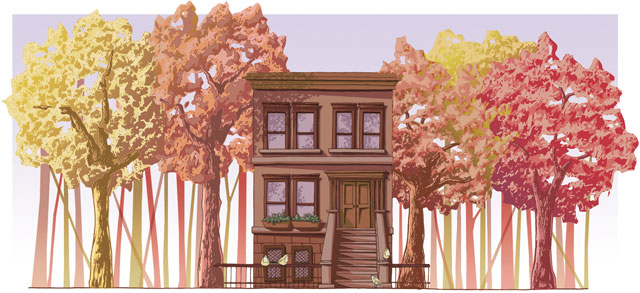 The range of early hominids was small: probably a 3 miles radius. My own territory here in Geneva isn’t nearly so large. In the cold weather especially, it becomes a series of interiors: the house, the car and Wegman’s supermarket, punctuated only by the cold, wet walk to the bus stop in the morning. To be fair my Brooklyn range was probably even smaller since most places we went were within walking distance. Still, the sheer numbers of people we encountered made it seem bigger. So it is that our world has grown simultaneously larger and smaller.
The range of early hominids was small: probably a 3 miles radius. My own territory here in Geneva isn’t nearly so large. In the cold weather especially, it becomes a series of interiors: the house, the car and Wegman’s supermarket, punctuated only by the cold, wet walk to the bus stop in the morning. To be fair my Brooklyn range was probably even smaller since most places we went were within walking distance. Still, the sheer numbers of people we encountered made it seem bigger. So it is that our world has grown simultaneously larger and smaller.
For a long time, the daily trip to the supermarket was my lifeline. I became one of the regular early luncheon crowd which mainly consist of retirees arriving in advance of the more youthful lunchtime rush at 12:30. I didn’t cotton on to the senior aspect until I complained to my neighbor about the lack of parking. Evidently, if I were a native Genevan, I would know that between the hours of 11:00 and 12:00 it is the custom for the local seniors to shop and have Italian Wedding Soup in the café; the parking lot is jam-packed.
I too have the soup – and with great humility. But for the grace of L’Oreal I would disappear into the silver crowd. And as the big Five-O draws nearer I become annoyed with disparaging comments about seniors like those I overheard from two Abercrombie and Fitch employees at the Eastview mall. They complained loudly that so many people in the Starbuck’s queue were “like, you know, old”. It was 20 degrees outside. They were wearing shorts.
I examine my roots in the mirror and picture myself as a grey-haired Boudicca hurling insults and spears at the Abercrombie and Fitch employees. It’s a darkly satisfying image even though it’s unlikely anyone would follow me. Shouting curses is rude and anyway, letting them shiver half-dressed in some dark and throbbing retail cave for minimum wage seems like divine retribution.
When not indulging in warrior queen fantasies over Italian Wedding Soup, I try to imagine what it must be like for Wegman’s two full-time sushi chefs.
Wegman’s Supermarket has a seemingly unshakable faith in the potential for sushi to go mainstream. The sushi station has been poised between the produce section and the café for a year and counting. Cheerful banners announce new creations like Spicy Shrimp Jalapeño sushi or Mango Chipotle rolls (Wegman’s has a “ Sushi Innovation Team”). Last week they launched “Crunchy Cajun Sushi”. But I don’t see many people buying it.
The sushi chefs try. They jump at any opportunity to explain the boxes on offer or to make recommendations. On occasion I have found myself apologizing for not having the Sushi. “Just checking it out” I stammer in a weirdly shrill voice. They smile politely. I avoid their eyes and imagine them crying themselves to sleep.
Are they Sushi evangelists by choice or worried for their jobs? The display overflows with colorful boxes of nigrizushi and California rolls, but it’s unclear whether this is the product of conscientious sushi making or a lack of interest. I search their faces for signs of hidden pain.
But who can read the sushi chefs with their cold steel knives? Perhaps I am patronizing them by casting them as victims in my own personal melodrama. In doing so am I not depriving them of their basic human dignity? I feel ashamed and grab a box of Cajun sushi.
The truth is I’m going a bit stir crazy. At first I thought I might be missing the city but as the days grow warmer I’ve realized it’s something else. I am missing the five-hour car journey from Brooklyn to Geneva. It’s as if Spring has awakened some dormant migratory instinct. I badly feel the itch to set off on a ramble.
Who’d have thought that five hours in the car could feel so necessary? In the years before we moved here permanently, The Journey was our escape from the 6:30 alarm, packing lunches and trips to the dry cleaner. Somehow, those long stretches on the highways with their billboards and mile markers gave us a sense of perspective we couldn’t find anywhere else. We dreamed and day-dreamed and talked and argued and laughed and sang along to the music that lives in the car.
First we headed up highway 80, through the Delaware Water Gap and into the Poconos. In the mountains the road carves through the water-bearing rock creating waterfalls or ice sculptures on either side, depending on the time of year. We hit Dickson City on the outskirts of Scranton by twilight.
O Scranton! Coal town, Steel town, Steam town, Lackawanna, Shelac-a-wanna. Do you wanna Dance? Home to museums of what you once were. O Scranton! It’s the sushi chefs all over again.
It was our custom to eat dinner at Perkins Restaurant in Dickson City. Perkins is the lesser of the many evils that are American family dining. It’s like Denny’s and Friendly’s but the food is marginally better, there’s slightly less cheese and the vegetables are less obviously microwaved from frozen. It is clean and the service is friendly. Less really is more.
I say “restaurant” but Perkins is desperate to be remembered as the bakery it was all those years ago in Minnesota before it became a chain. Every season is pie season at Perkins. Spring is strawberry, summer peach autumn, pumpkin and winter lemon meringue. The children’s placemats are decorated with the “bakery” buddies: Marty the Muffin, Patty the Pie, Kelly the Cookie, Bobby the Brownie and Jeff the Chef. I find them strangely reminiscent of gangster movies.
I imagine Marty the Muffin is the head of the family. Bobby the Brownie is the Marty’s captain and Patty the Pie is a hit man. Kelly the Cookie is Bobby’s wife and Jeff the Chef is the mob lawyer. When Bobby talks to the feds, Marty takes a contract out on him. Bobby and Kelly go into witness protection but Patty the Pie is headed to Scranton…
In seven years we’ve never ordered dessert, but the waitresses are determined for us to have the big half-sugar, half-chocolate chip mega cookies that come with the kid’s meals. The children are disinterested but still the staff flags us down in the parking lot with heart-breaking earnestness to give us the cookies we “forgot”. So we take them. Sometimes we toss them but more often my husband breaks down and eats them around the time we hit Vestal.
As night falls we continue up Route 380 toward Binghamton where we’ll pickup Route 17. It’s so much darker than the city and the sky so crowded with stars, it almost feels like another world. In some ways it is.
If Edward Hopper were alive today, I believe he would paint the Dunkin’ Donuts where couples absently stir their coffees while watching their ghostly reflections in the windows. Edward Hopper and I are watching from the parking lot.
We break off Route 17 at Owego, sneaking out the back way by the Open Door Mission bound for Route 96A and an even smaller road beyond. This is my favorite leg of our journey.
I watch for milestones and they come. First the lonely pink elephant, the focal point of the miniature golf course with pizza-restaurant-attached. There’s the bright yellow mailbox decorated with the silhouettes of a cat, dog, and a bird. Beneath them someone has stenciled the words “God Bless America”.
There’s the crudely rendered brush sign for Brush and Pallet Auto rising above the mishmash of cars. Like all used car lots, the PT Cruiser is parked in front.
Twenty-eight black bears stand guard in the yard of the chain saw sculptor and a little further on Ye Olde Christmas Shoppe has closed for the season and forever. Space is available.
Two turns, one stop sign, and one set of traffic lights later we reach the crest of the hill overlooking Seneca Lake. For a moment it’s like taking flight with all the hundreds of twinkling lights clustered down below then we plunge down to Montour Falls, Watkins Glenn and Route 14. Trucks must use brakes.
We pass the marsh, the tire store with its life-sized fiberglass sculptures of The Blues Brothers, Watkins Glenn State Park, and cruise into the quiet downtown. Quiet except for the Rooster Fish Brewery. Then we drive up a gentle hill, past a motel ministry to reach the lakeshore.
Route 14 is all farms, vineyards and wineries. We pass the yellow barn. The last 25 minutes is like a trip to the wine store: Glenora, Herman J. Weimer, Prejean, Red Tail, Anthony Road, Fox Run, Billsboro, White Springs then two left turns and home.
“What are you writing about?“ My husband asks.
“How much I miss the drive up here… and my worries about the sushi chefs.”
“Oh don’t worry about them. When I was there the other night they were selling it hand-over-fist”

 When we left New York City, I worried that culture might be hard to come by. Oh the luxury of having film festivals and museums, concerts and exhibitions on your door step! Not that we took full advantage at the time. Still, as Woody Allen says about ordering chinese food in the middle of the night in New York City, it was nice to know it was there.
When we left New York City, I worried that culture might be hard to come by. Oh the luxury of having film festivals and museums, concerts and exhibitions on your door step! Not that we took full advantage at the time. Still, as Woody Allen says about ordering chinese food in the middle of the night in New York City, it was nice to know it was there. Autumn is giving way to Winter here in Geneva. The leaves are mostly fallen except for the golden topped hardwoods that rise above our gravel road like the arches of a cathedral. I have taken to incessantly posting photos of this route on Facebook: photos taken at dusk and dawn, photos with children for scale, photos of VERY RED leaves. The diminishing “likes” and comments hint at what I know in my heart: there can be too much of a good thing.
Autumn is giving way to Winter here in Geneva. The leaves are mostly fallen except for the golden topped hardwoods that rise above our gravel road like the arches of a cathedral. I have taken to incessantly posting photos of this route on Facebook: photos taken at dusk and dawn, photos with children for scale, photos of VERY RED leaves. The diminishing “likes” and comments hint at what I know in my heart: there can be too much of a good thing. Park Slope is like the Island of the Lotus Eaters. Decide to leave and it offers up delight upon delight. Suddenly there will be a thousand reasons why now is not the time.
Park Slope is like the Island of the Lotus Eaters. Decide to leave and it offers up delight upon delight. Suddenly there will be a thousand reasons why now is not the time.